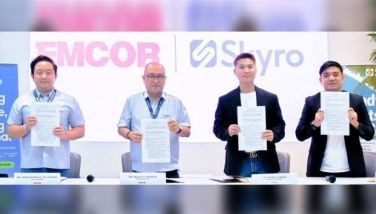‘Hybrid’ PPPs

The Philippine economy grew by as much as 7.1 percent in the third quarter of this year, the Philippines Statistics Authority (PSA) announced yesterday. According to government economic monitoring, the country’s latest gross domestic product (GDP) made the Philippines as the fastest growth area in Asia.
Days before the PSA made this announcement of the country’s quarterly economic performance, this was the official statement rendered by Department of Budget and Management (DBM) Secretary Benjamin Diokno to the ambassadors of the 28-member states of the European Union (EU). Apparently briefed already by the PSA, Diokno gave heads up to the EU ambassadors about the fast-growing economy of the Philippines that their respective countries might miss to join.
Though he did not go into details yet, Diokno already intimated to us the big news during our weekly Kapihan sa Manila Bay. He was our guest in this week’s breakfast forum last Wednesday at Café Adriatico in Manila. Despite verbal tirades of President Rodrigo Duterte against the EU on human rights issue against the administration, Diokno noted, the EU ambassadors were more interested about the Philippine economic prospects that their respective countries can cash in.
Diokno was invited by the EU ambassadors to brief them about the 10-point economic policy directions of the new administration. Diokno impressed upon them the end goal to achieve sustainable growth for the next six years of the new administration is to cut or reduce poverty incidence in the country by 1.25 to 1.5 percent every year.
With more jobs created, he pointed out, it will mean increased income and generate savings for all Filipinos, not just for the business and the rich sectors of society.
These are the real ways that GDP growth would be truly felt by the poorest of the poor Filipinos.
The economic performance report for the third quarter was released a few hours before President Duterte flew yesterday for Lima City to attend the Asia Pacific Economic Cooperation (APEC) Leaders’ summit taking place in Peru’s capital this week.
But President Duterte himself seemed to be unimpressed with the hefty GDP growth rate this quarter even if the period in review covered his first four months into office. Digressing from his prepared departure speech at the Davao City International Airport, President Duterte likened the Philippine economy as always on the takeoff mode at the runway. “Nasa runway lang tayo hanggang ngayon (we’re stuck at the runway until now),” the President rued.
To finally put the country’s economy on flight mode eventually, Diokno cited the proposed 2017 budget pours a total of P860.7 billion to infrastructure development, or equivalent to 5.4 percent of GDP. This is an increase of 13.8 percent on year-to-year comparison.
Diokno is, in fact, shepherding the approval of the 2017 budget bill before the 17th Congress. The 2017 budget bill is in last stages of deliberations at the Senate for final approval this week. The House of Representatives earlier approved it. The two chambers will convene in a bicameral conference committee to consolidate the final version of the budget bill.
Incidentally, the proposed 2017 budget bill is still a version of the previous administration of President Benigno “Noy” Aquino III. This will be the first budget bill though that President Duterte will sign into law. Given the timetable agreed upon by both chambers of Congress, Diokno is confident this can be signed into law before the end of December.
Under the administration’s economic blueprint, Diokno disclosed budget for infrastructure development would reach 7.2 percent of GDP by 2022, or at the end of term of President Duterte. On peso terms, the DBM Secretary said this would amount to as much as P9 trillion between 2017 and 2022.
In layman’s language, Diokno explained, more than one-fourth of the national budget will be invested in the next six years by the Duterte administration on infrastructure programs and projects to inter-connect growth areas, support agriculture and tourism development, spur trade, livelihood and encourage more private investments.
According to the International Monetary Fund (IMF) economic experts, Diokno cited, inadequate infrastructure is one of the major impediments to private investments, including foreign investors.
Diokno disclosed the Duterte administration will also capitalize on the Public-Private Partnership (PPP) Program, including unsolicited proposals to accelerate the roll out of infrastructure projects. He echoed the Duterte policy not only to continue the good programs of his predecessors like the PPP, but also improve upon them.
Diokno said the Duterte administration prefers to adopt a “hybrid” type of PPP. Under this “hybrid” type of PPP, Diokno explained, the proposed project would be put up through official development assistance (ODA) since such loan facility has highly concessional rates and long repayment period.
Diokno cited in particular Japan ODA that offers not more than 2.5 percent interest rate, with 40 years to pay, plus ten-year grace period. “It’s practically a giveaway,” Diokno quipped.
Once the PPP project is put up, he said, it would be offered for public bidding to any interested companies to operate and manage it. “The government is not a good manager anyway,” he conceded.
The DBM Secretary obliquely confirmed reported findings by an IMF review about contingent liabilities that would be shouldered by the government on nine Aquino-approved PPP projects. The contingent liabilities represent sovereign guarantees granted to certain Aquino-approved PPP projects that would be in the account of the government.
“Relatedly, we are aware of the implications of these PPP projects that may in any eventuality in the future we may encounter possible contingent liabilities,” Diokno said without going into details. Hence, he disclosed, P30 billion has been provided for the Risk Management Program under the Unprogrammed Fund as “standby fund” to be tapped when the contingent liability becomes real.
This is to manage the national government’s fiscal risk basically to cover commitments made by and obligation in concession agreements relative to PPP projects, he assured us. Resident economist of Congress, Albay Rep.Joey Salceda is unappeased. He wanted the House to look into these Aquino-approved PPPs, not the “hybrid” ones.
- Latest
- Trending


























